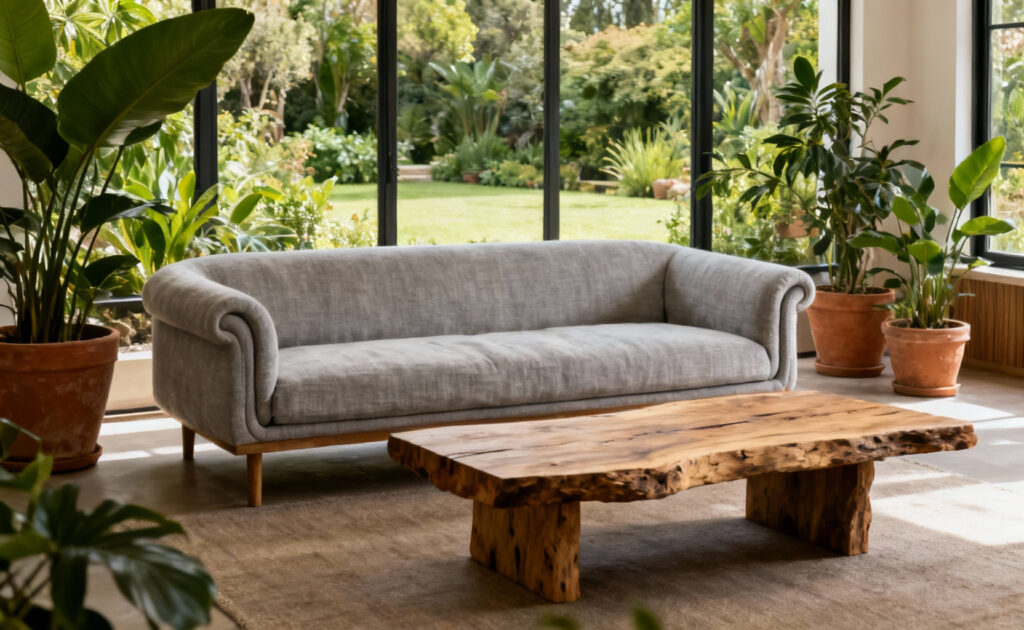Designing a home is fundamentally an act of self-revelation—every choice we make reflects not just aesthetic preference, but deeper values about how life should be lived and felt. The most compelling living spaces are not simply decorated; they’re composed. They tell a coherent story about who we are and who we aspire to be. In my work as a wellness design consultant, I guide people to understand that our environments are active participants in our health. And this is especially true of the living room—the very heart of the home.
These 20 principles separate a living room that simply looks good from one that actively nurtures your well-being. We will move through four distinct pillars of thought: beginning with the foundational choices that anchor a sense of calm, then exploring the sensory world of materials, mastering the flow of space, and finally, integrating furniture that adapts to the beautiful fluidity of your life. This isn’t about trends; it’s about creating a true sanctuary.
Anchoring Serenity: Foundational Choices for Calm
Before we choose a single piece, we must first establish our intention. What feeling do we want our living room to evoke? The most resonant spaces are built on a philosophical foundation that prioritizes psychological comfort, innate calm, and deep connection—not just to the space, but to ourselves.
1. Embrace Biophilic Principles for Innate Comfort
Our biology has an ancient, deep-seated need to connect with nature. It’s a principle we call biophilia. When we select furniture that reflects natural patterns, materials, and forms, we are answering a primal call for calm. This isn’t just about adding a plant; it’s about choosing a coffee table made from a solid piece of oak, where you can still see the life in its grain, or a sofa with soft, organic curves that mimic the rolling shapes of a landscape.
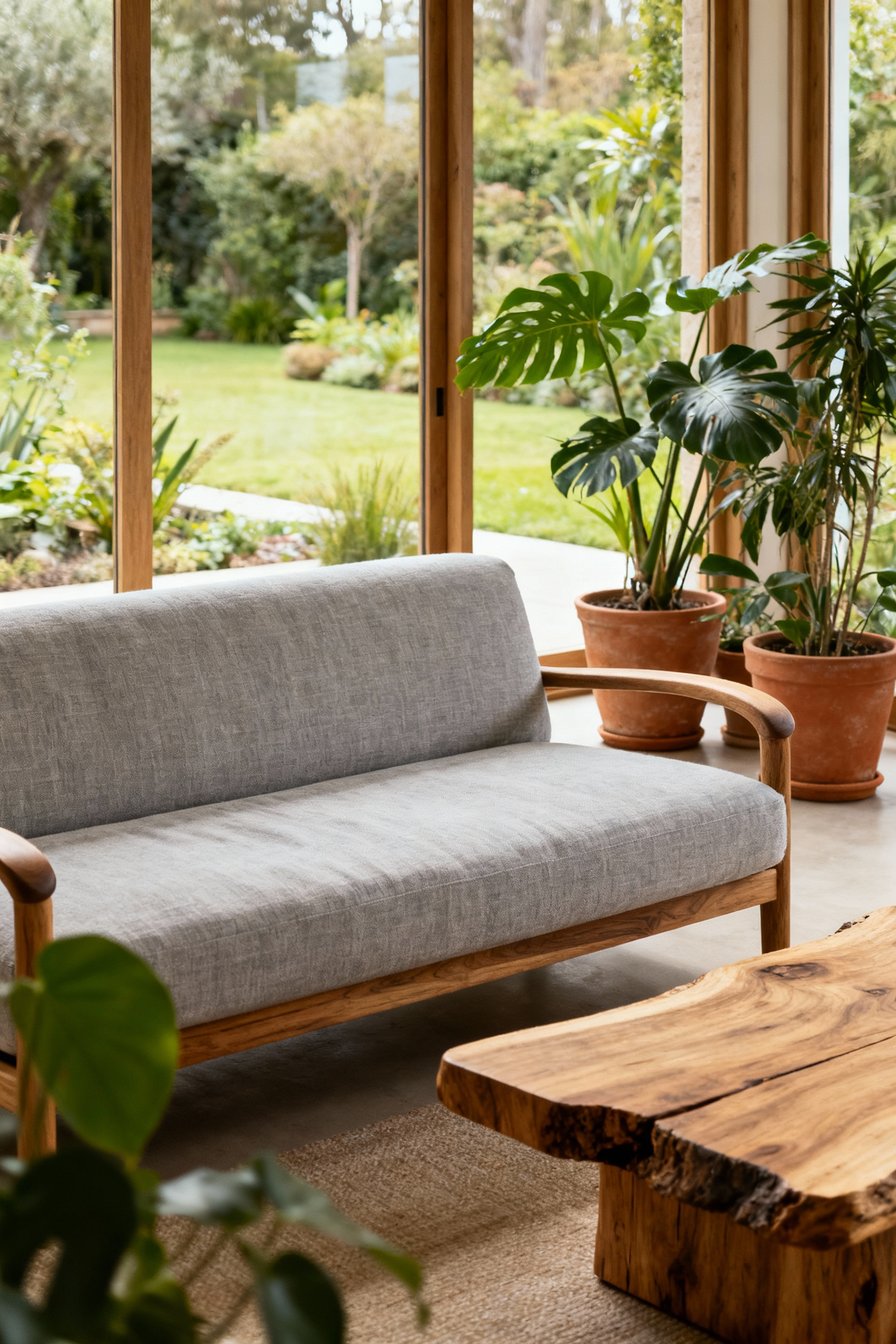
These choices have a scientifically-backed ability to lower cortisol levels and soothe our nervous systems. What I tell my clients is to think beyond the obvious. Instead of a perfectly symmetrical piece, look for the beautiful imperfection of a live-edge console. This conscious choice to bring the ‘outside’ in creates a space that doesn’t just look natural—it feels inherently right, on a biological level.
2. Assess the Emotional Resonance of Form
Every piece of furniture communicates with us nonverbally through its shape. Sharp, aggressive angles and rigid lines can signal formality, structure, and even tension. Soft curves, rounded edges, and gentle slopes, on the other hand, convey safety, comfort, and an invitation to relax. This is the energetic language of design.
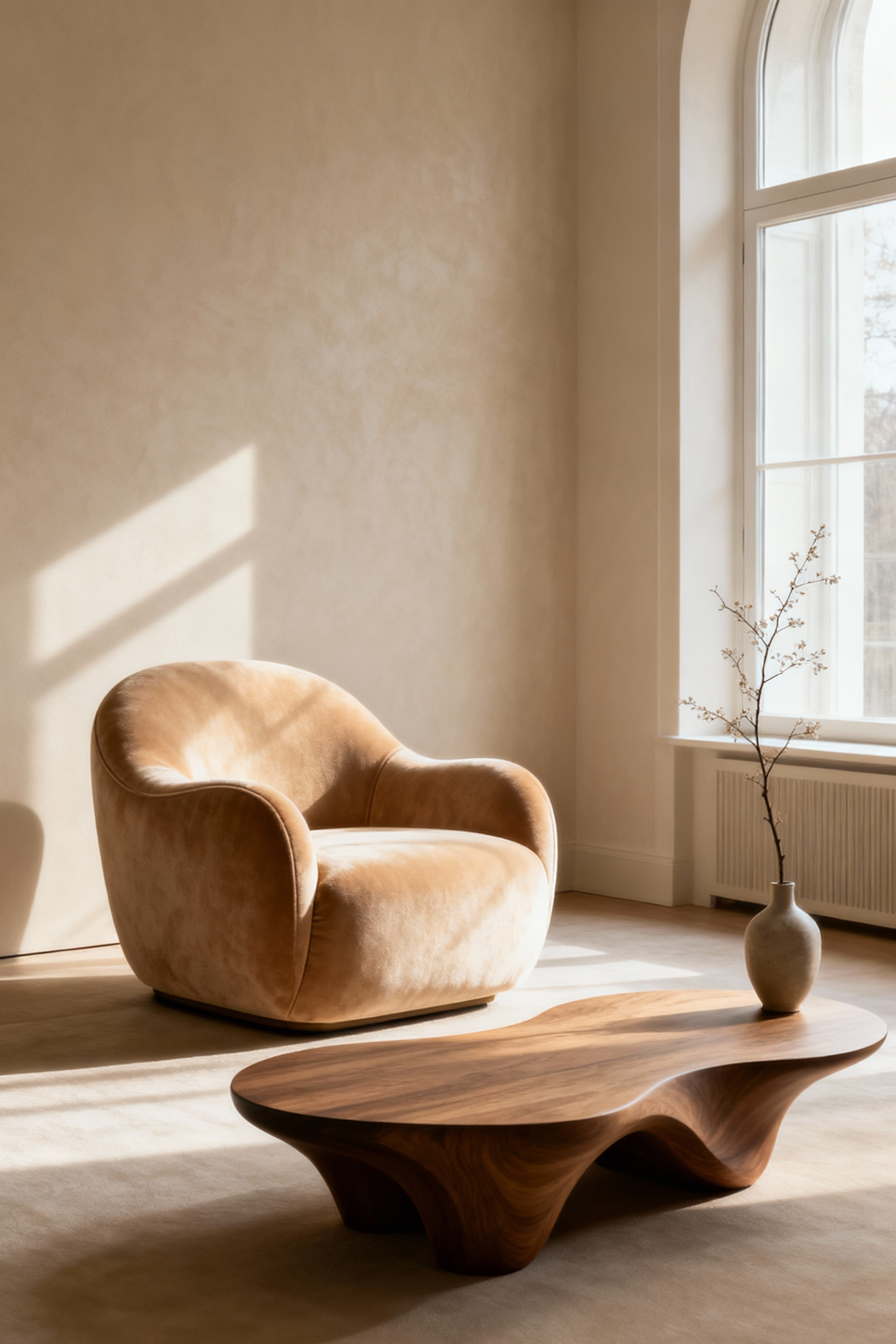
Before you choose a sofa or an armchair, consider the emotional state you wish to cultivate. Do you want your living room to be a dynamic hub for lively debate or a soft cocoon for quiet retreat? A sculptural armchair with a commanding presence creates a very different feeling than a low-slung, deep-seated sectional that beckons you to curl up. In my professional experience with mindful space planning, aligning the silhouettes in your room with your desired feeling is one of the most powerful—and often overlooked—tools for creating a true sanctuary.
3. Implement Ergonomics for Physiological Support
True well-being is impossible if our bodies are in a constant state of low-grade discomfort. Ergonomics is the science of designing for the human body, and it’s a non-negotiable pillar of wellness design. A beautiful sofa that offers no lumbar support or an armchair that forces your shoulders to hunch is actively working against your health.
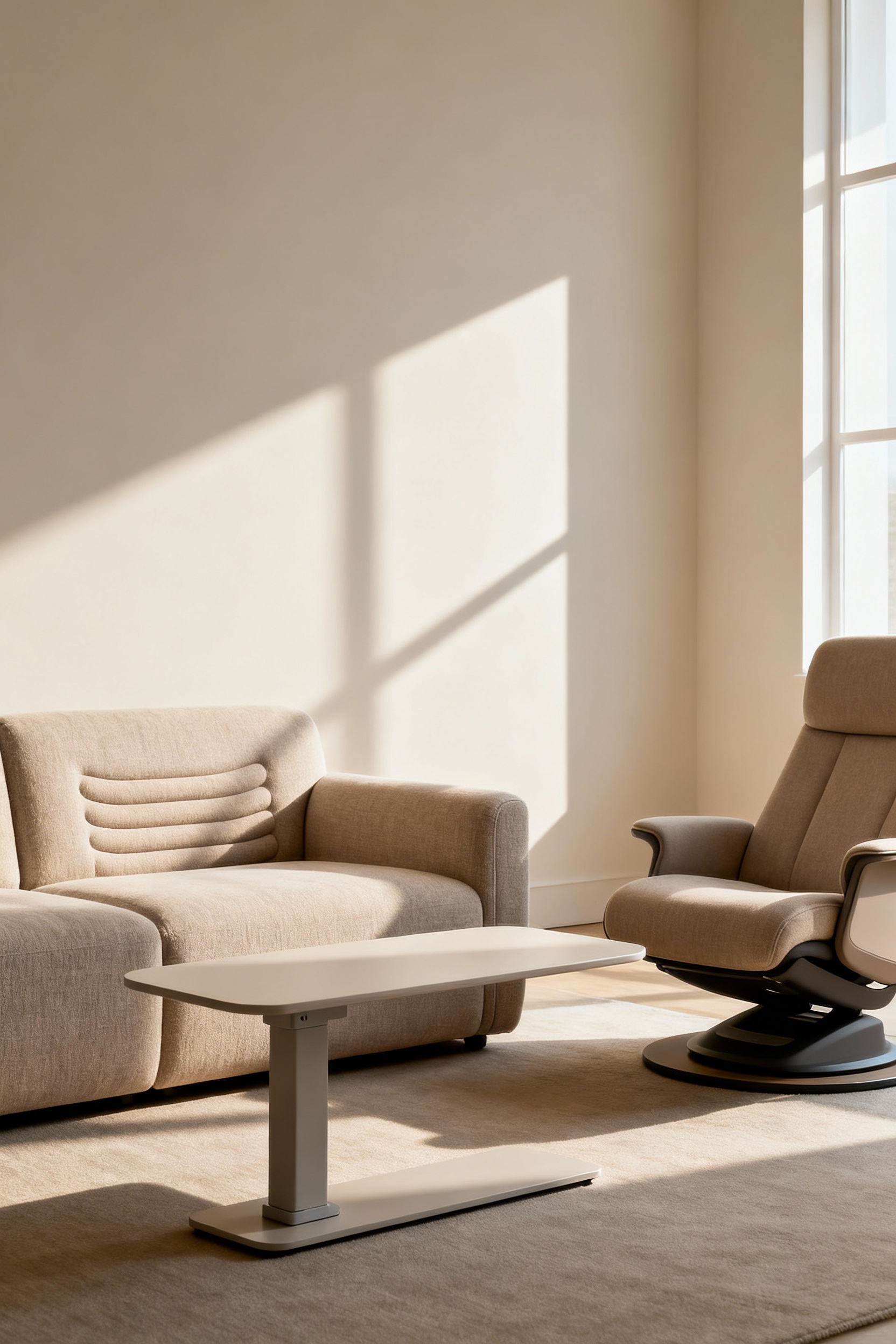
This means considering seat depth, back height, and armrest position. Your feet should be able to rest comfortably on the floor when seated, and your spine should feel supported in its natural curve. Years of professional experience have taught me that furniture is a long-term investment in your physical health. When your body is truly at ease, your mind is free to relax, connect, and restore.
4. Evaluate the Lifecycle for Ecological and Personal Wellness
Our sense of well-being is inextricably linked to our values. When our actions align with our beliefs, we experience a state of integrity and peace. This extends to the furniture we buy. Evaluating a piece’s lifecycle—from how its materials were sourced and milled, to the non-toxic finishes used, to its durability and end-of-life potential—is an act of conscious consumerism.

Choosing furniture made from sustainably harvested wood, upholstered in natural fibers, and built to last for generations creates a healthier home by reducing exposure to harmful chemicals. But it also nurtures a healthier conscience. Surrounding yourself with objects that were made with care for both people and the planet contributes to a profound sense of inner calm, knowing your personal sanctuary isn’t creating harm elsewhere.
5. Arrange Seating to Foster Connection and Introspection
The way we arrange our furniture choreographs our interactions. Do your chairs face each other to encourage conversation, or are they all oriented towards a screen? A truly holistic living room accommodates our dual needs for both social connection and quiet introspection. This isn’t about one right way; it’s about creating intentional zones.
You might create a primary conversation area with two sofas facing each other. Then, in a corner near a window, place a single, comfortable armchair with a small table and a lamp. This creates a dedicated nook for reading or quiet contemplation—a personal sanctuary within a shared space. By arranging your furniture with this psychological awareness, you are consciously designing a room that supports every facet of your being.
Haptic Harmony: Materiality for Sensory Well-being
Our skin is our largest organ, and our sense of touch provides a constant stream of information to our brain about our environment. The materials we choose to surround ourselves with are not passive backdrops; they are in an active dialogue with our nervous system. A haptically rich space is a deeply nourishing one.
6. Select Natural Fibers for Air Quality and Tactile Pleasure
The feel of a fabric against our skin has an immediate impact on our sense of comfort. Beyond that, the materials we choose for upholstery directly affect our home’s indoor air quality. Synthetic fabrics like polyester or nylon are often treated with chemicals and can off-gas volatile organic compounds (VOCs), which are known respiratory irritants.
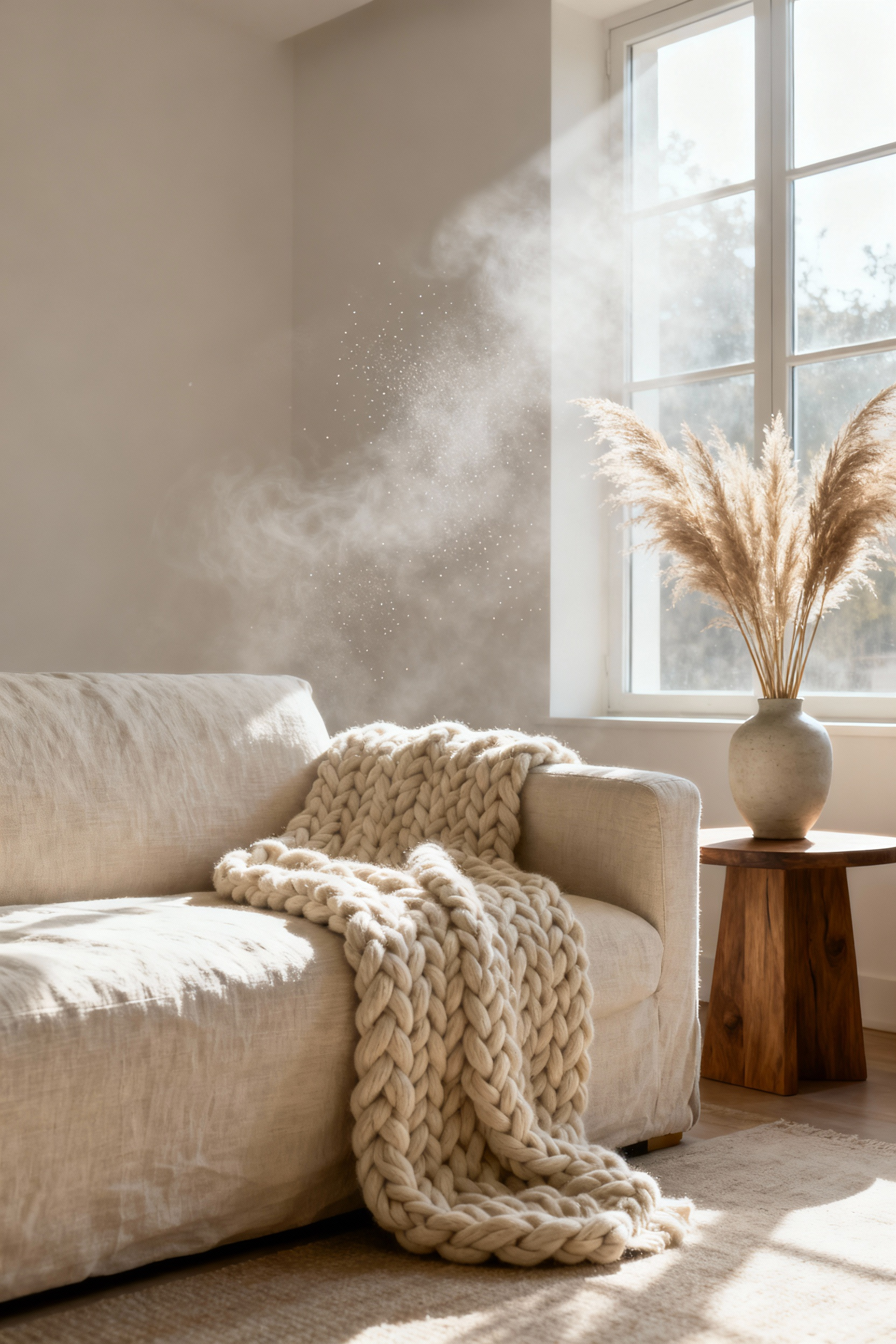
Natural fibers like linen, organic cotton, wool, and hemp are breathable, hypoallergenic, and non-toxic. They also offer a far superior tactile experience—the cool smoothness of linen, the substantial warmth of wool, the soft familiarity of cotton. I’ve noticed in my wellness design practice that when a client switches to natural-fiber upholstery, they don’t just comment on the look; they talk about how the room feels calmer and healthier.
7. Integrate Sustainable Wood and Non-Toxic Finishes
Wood is a fundamentally grounding material. It connects us to the earth and lends a sense of stability and permanence to a space. When choosing wood furniture—like a coffee table, console, or bookshelf—look for pieces made from reclaimed timber or sustainably harvested (FSC-certified) wood.

Just as important is the finish. Many conventional wood finishes contain high levels of VOCs that compromise indoor air quality for years. Instead, opt for pieces treated with natural oils like tung or linseed, or finished with beeswax or low-VOC water-based sealants. These finishes don’t create a plastic-like barrier; they enhance the natural beauty of the wood grain, offering a more authentic visual and tactile connection to the material.
8. Use Reflective and Matte Surfaces to Sculpt Light
Light is the artist that paints our rooms, and the surfaces of our furniture are the canvas. The interplay of light and texture profoundly shapes a room’s mood. Reflective surfaces—a polished brass detail, a glass tabletop, a subtly lacquered console—bounce light around, creating energy, brightness, and a sense of expansiveness.

Matte surfaces, in contrast, absorb light, creating a feeling of softness, quiet, and intimacy. Think of the deep, light-swallowing quality of a velvet sofa, the soft finish of raw oak, or the texture of unglazed pottery. A well-designed room uses both. The strategic balance between reflective and matte surfaces allows you to sculpt the light, creating a dynamic, layered environment that feels both alive and serene.
9. Curate Earth Tones to Evoke Visual Calm
Color has a direct and immediate impact on our psychological state. While vibrant colors can be energizing, a living room intended as a sanctuary benefits immensely from a palette of muted hues and earth tones. Soft sage greens, dusty blues, warm greys, creamy terracottas—these colors are drawn from the natural world and have a grounding, calming effect.

A palette based on these tones reduces visual overstimulation, allowing the eyes and mind to rest. It creates an enveloping sense of harmony, where the furniture doesn’t compete for attention but coexists in a beautiful, cohesive landscape. This doesn’t mean the room has to be boring. You can create immense depth and interest through subtle variations in shade and texture within your chosen palette.
10. Employ Acoustic-Absorbing Elements for Auditory Comfort
A truly serene space is quiet. Hard surfaces like wood floors, glass windows, and bare walls reflect sound, creating an echoey, sometimes jarring environment. Our living room furniture can serve as a powerful tool for sound absorption, softening the room’s acoustics and fostering auditory comfort.
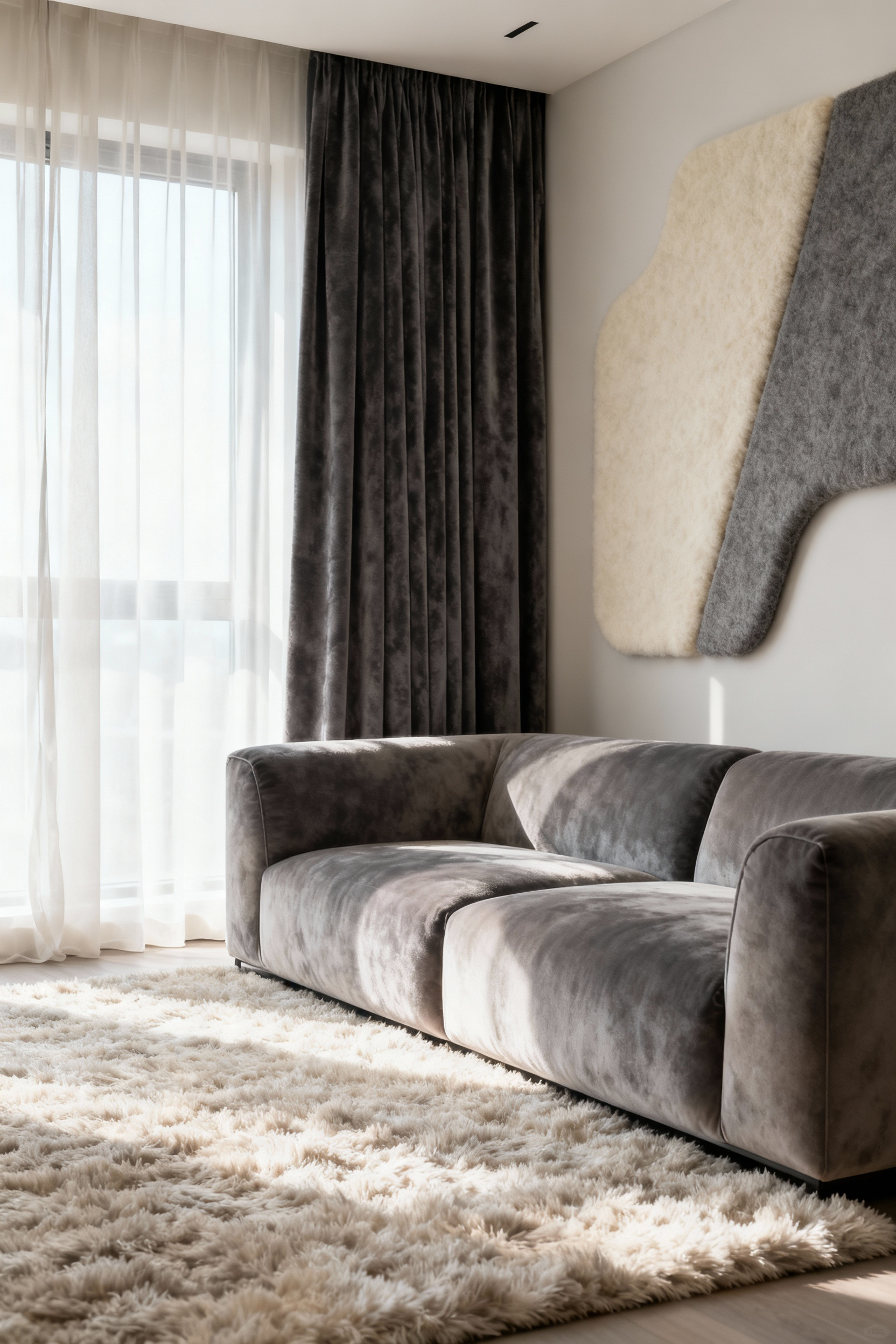
Soft, upholstered pieces—a deep sofa, plush armchairs, a large ottoman—are incredibly effective at absorbing sound waves. Wool rugs, heavy draperies, and even a well-stocked bookshelf help break up and dampen sound. Here’s what’s truly interesting: designing for acoustic comfort actually enhances intimacy. In a sonically soft room, conversations can happen at a lower volume, creating a more relaxed and connected atmosphere.
Spatial Choreography: Layout for Energy and Flow
How we arrange our furniture is a form of choreography. It dictates how we move, how we interact, and how energy—or qi—flows through a space. Mastering this choreography is essential for creating a room that feels effortless, intuitive, and supportive of our daily lives.
11. Design Zonal Configurations for Diverse Activities
A modern living room is rarely used for a single purpose. It’s where we relax, entertain, work, read, and play. Instead of treating it as one monolithic space, think of creating distinct zones for different activities. A carefully placed rug can define a conversation zone. A comfortable armchair and a floor lamp can create a reading nook.

This “room within a room” concept allows the space to support multiple needs simultaneously without feeling chaotic. In my mindful space planning, I use furniture itself to suggest these zones. A low bookcase behind a sofa can create a subtle separation, defining a walkway or a small workspace without putting up a physical wall. This approach makes the room incredibly functional and adaptable.
12. Calibrate Scale for Visual Harmony
The relationship between the size of your furniture and the size of your room is crucial for creating a sense of balance. A massive, overstuffed sofa can make a small room feel cramped and overwhelming. Conversely, small, delicate furniture can feel lost and insignificant in a large, open-plan space. The goal is visual harmony.

There should be a comfortable balance between positive space (the furniture) and negative space (the empty areas around it). Before you buy, measure your room and map out the furniture on the floor with painter’s tape to get a real feel for the scale. When everything is in proportion, the room feels settled, calm, and effortlessly correct.
13. Optimize Walkways for Unobstructed Flow
There should be nothing stressful about walking through your living room. Clear, intuitive pathways allow for easy movement and a subconscious sense of freedom. Cluttered or narrow walkways create physical and mental friction, signaling restriction and causing low-grade stress.

Aim for at least 30-36 inches of clearance for major walkways. The path between your sofa and coffee table can be a bit tighter, around 18 inches. Thinking about these circulation paths is a key aspect of Feng Shui principles. When energy can flow freely through a room, it feels more vibrant, open, and welcoming. This small detail has a massive impact on the daily experience of the space.
14. Integrate Multifunctional Pieces for Adaptability
In today’s homes, especially smaller ones, furniture that can serve multiple purposes is not a novelty—it’s a necessity for well-being. A storage ottoman can be a footrest, extra seating, and a place to hide away clutter. A console table can double as a slim-profile desk. A modular sofa can be reconfigured for different needs.

Choosing multifunctional furniture allows you to live more fully with less. It’s a minimalist ethos that directly supports mental clarity by reducing the sheer number of objects in your space. The key is to select pieces that perform each of their functions beautifully, without compromise. This adaptability makes your home more resilient and responsive to the changing demands of your life.
15. Position Key Furniture to Leverage Natural Light and Vistas
Natural light is a potent mood-booster and vital for regulating our circadian rhythms. When arranging your living room, think of your windows as living art. Position a favorite armchair to catch the morning sun. Arrange your main seating area to take advantage of a beautiful view.
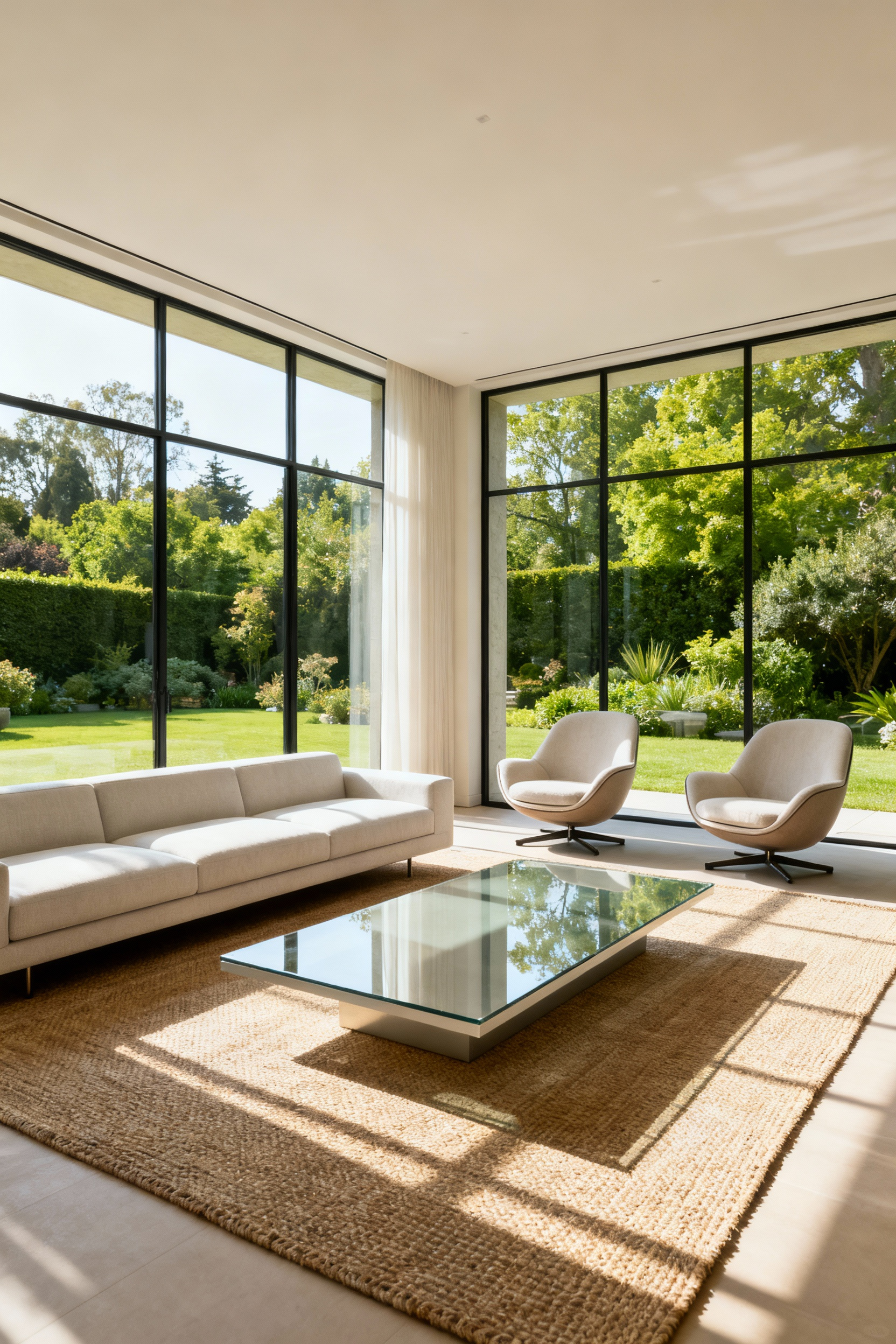
This simple act of orientation connects your indoor sanctuary to the world outside, grounding you in the natural cycles of the day. Be mindful of glare on screens, but don’t be afraid to let your furniture embrace the light. From my work, I’ve seen that a space filled with dynamic natural light—the shifting patterns of sun and shadow—feels more alive, soulful, and deeply restorative.
Lifestyle Alchemy: Adaptable Systems for Modern Life
Our homes should not be static museums. They should be living, breathing ecosystems that evolve as we do. The final pillar of wellness design is about choosing furniture systems that are adaptable, personalized, and can be intentionally curated over time to align with our ever-changing lives.
16. Select Modular Seating for an Evolving Lifestyle
Life isn’t static, and your seating shouldn’t be either. A modular sectional sofa is the ultimate piece of adaptable furniture. It can be reconfigured from an L-shape for family movie nights to separate sofas for a party. A single chaise can be pulled away for a quiet reading spot.
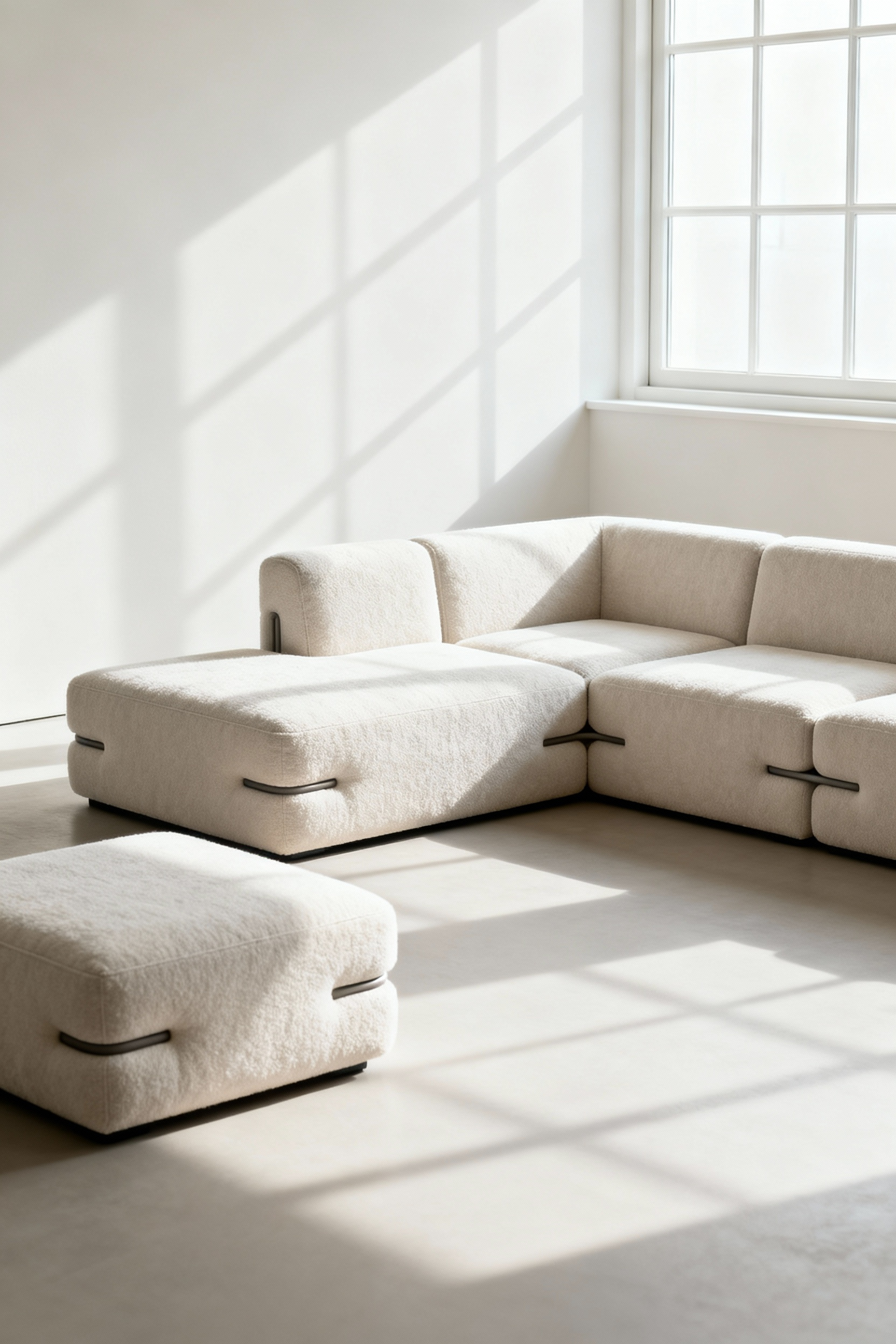
This flexibility empowers you to become the active architect of your environment. You can reshape your living room to suit your needs on any given day, week, or year. For families with growing children or anyone whose living needs are in flux, modular systems are a brilliant investment in long-term functionality and well-being. They honor the reality that our needs change.
17. Integrate Discreet Storage for Mental Calm
Visual clutter translates directly to mental clutter. Our brains are hardwired to process everything in our line of sight, and a disorganized space creates a constant, low-level cognitive load. Integrating smart, discreet storage into your living room furniture is one of the most effective ways to cultivate a calm mind.
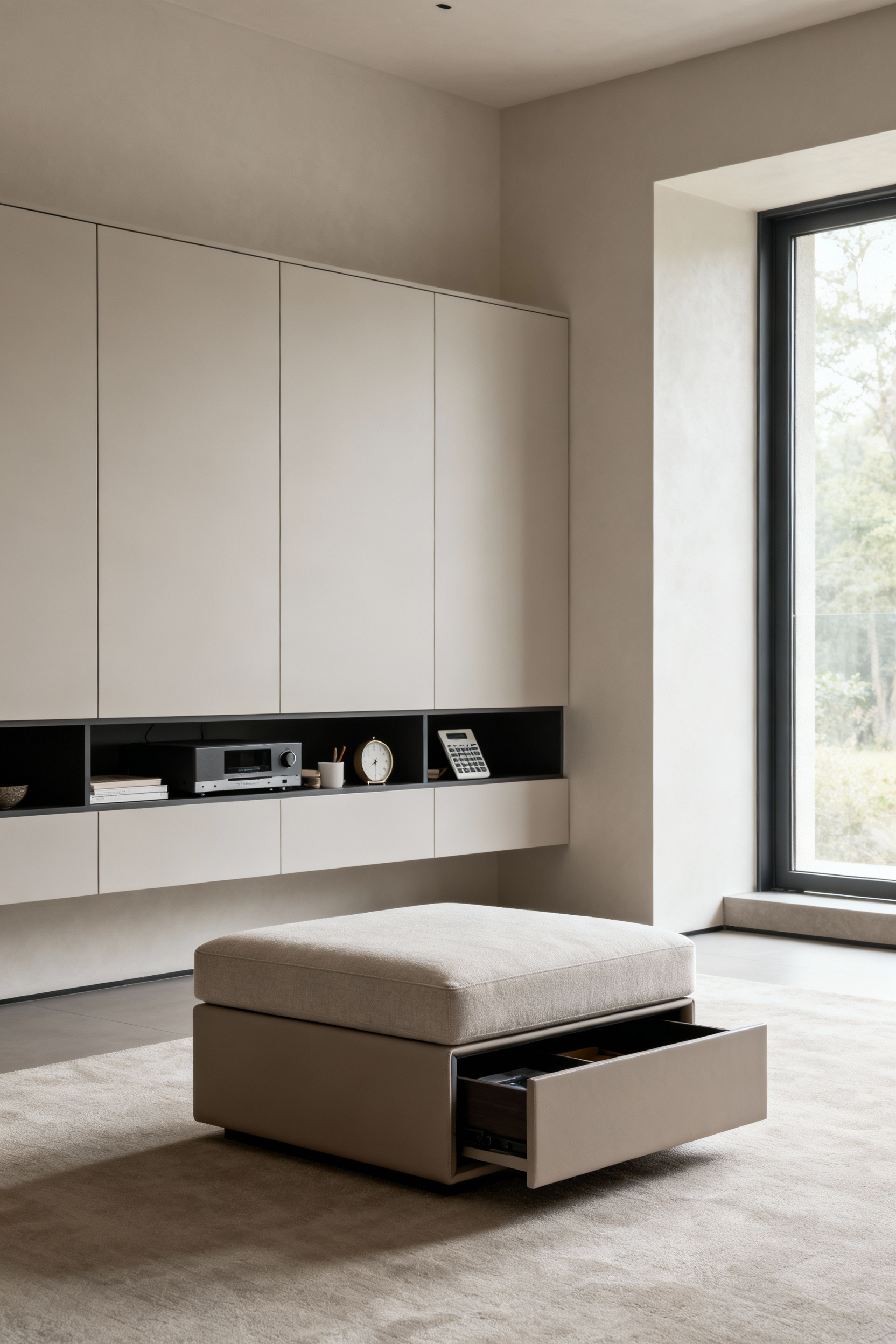
Think of coffee tables with hidden lift-tops, side tables with drawers, or a media console that stylishly conceals all the wires and devices. When everything has a designated home and can be tucked away out of sight, your living room transforms into a serene, uncluttered oasis. The daily ritual of putting things away becomes a small act of mindfulness that resets the energy of the space.
18. Specify Smart Furniture for Seamless Technological Symbiosis
Technology should serve us, not dominate our spaces. The best smart furniture integrates technology so seamlessly that it feels intuitive and invisible. This could be a side table with a built-in wireless charging pad, a sofa with discreet USB ports, or lighting that can be adjusted via a simple voice command.
The goal is to reduce “techno-stress”—the friction of dealing with tangled cords, dead batteries, and multiple remotes. By thoughtfully integrating these conveniences into the very structure of our furniture, we create a living environment that is more responsive, supportive, and effortlessly functional, freeing up our mental energy for what truly matters.
19. Prioritize Customization to Reflect Individual Needs
A space that truly nurtures us is one that feels authentically our own. Off-the-shelf furniture doesn’t always meet our unique needs, whether it’s an oddly shaped room, a specific physical requirement, or simply a deeply personal aesthetic vision. Prioritizing furniture that offers customization options is an investment in a perfect fit.

This might mean choosing the exact fabric and fill for your sofa, specifying the height of an armchair for ergonomic support, or commissioning a bookshelf that fits a particular nook perfectly. I learned this when designing a space for a client with specific mobility needs; a custom-height chair wasn’t a luxury, it was essential for their independence and comfort. When your furniture is tailored to you, it elevates the entire experience of being home.
20. Conduct Regular Audits to Align Space with Your Intentions
Finally, understand that your living room is a relationship, not a finished project. Just as we evolve, our spaces must be allowed to evolve with us. I encourage my clients to conduct a small, mindful audit of their living room every six months or so. Ask yourself: Does this space still support who I am now?
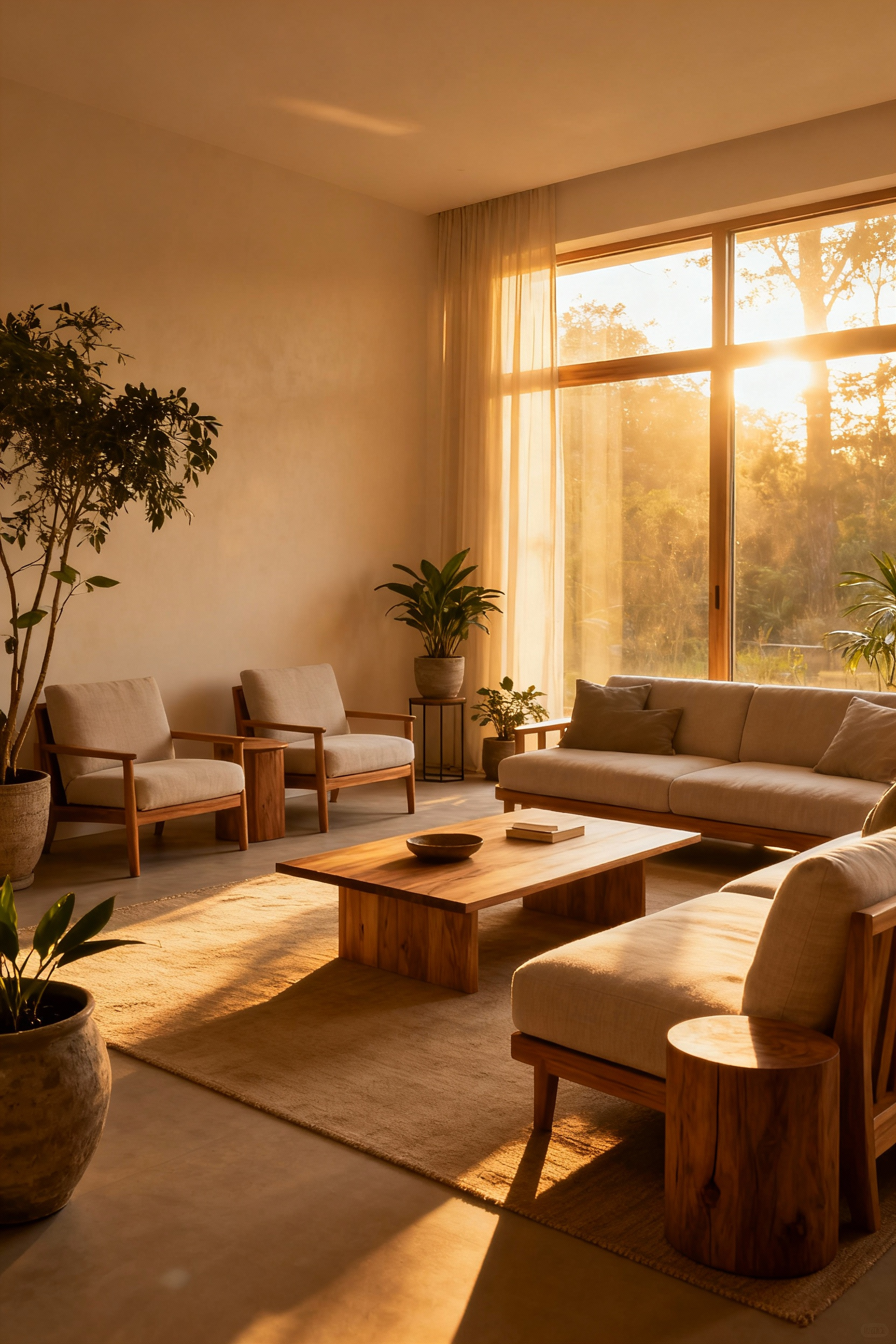
Perhaps a chair needs to be moved to create better flow, or maybe it’s time to let go of an object that no longer brings you joy. This practice of conscious curation ensures that your living room remains a dynamic and authentic reflection of your wellness journey. It transforms your home from a static container into an active, responsive partner in your well-being.
Conclusion
Our journey through these twenty principles reveals a simple but profound truth: the choices we make for our living room furniture are deeply intertwined with our quality of life. We’ve moved from the philosophical underpinnings of serenity to the tangible, sensory world of materials, and finally to the dynamic choreography of space and lifestyle. Every element matters. Every selection is an opportunity to infuse our daily lives with more calm, more connection, and more authentic joy.
As you move forward, I invite you to see your home not just as a place to live, but as a practice of living well. View each piece of furniture not as a mere object, but as a tool for sculpting an environment that actively supports your best self. May your living room become a sanctuary that reflects your values, restores your energy, and serves as a beautiful, enduring foundation for a life lived with intention and peace.
